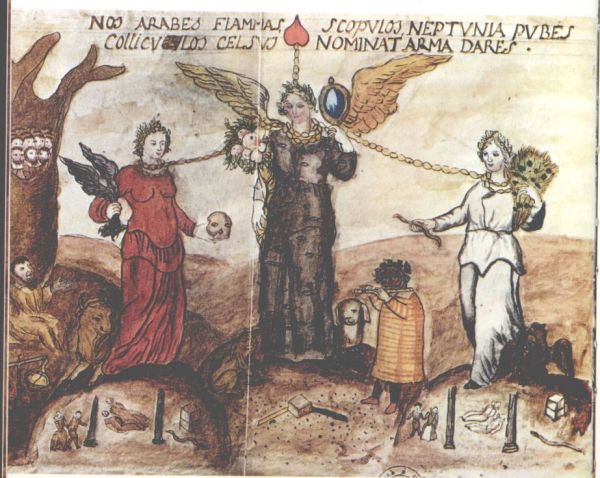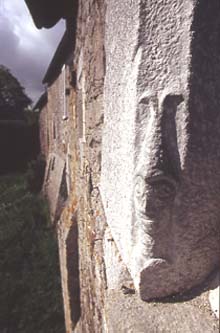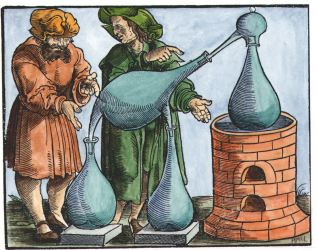| Author | Post |
|---|
adammclean
Member

| Joined: | Fri Sep 14th, 2007 |
| Location: | United Kingdom |
| Posts: | 606 |
| Status: |
Offline
|
|
Posted: Thu Nov 13th, 2008 11:23 pm |
|
The Bibliothèque L'Arsenal in Paris has a manuscript (3019) of Les cinq livres de Nicolas Valois, dated to the 18th century. This has a rather interesting coloured drawing on parchment. I have been struggling to understand the Latin text at the top which seems to read
nos arabes flammas , scopulos , neptunia pubes colliculos celsus nominat arma dares.
Paul Ferguson has kindly made some suggestions regarding the translation of this difficult phrase, but I wonder if anyone else has looked at it.
Interestingly, a painting (apparently 17th century) based on this was sold at an auction in France in December 2003. This was in the possession of a Pr. Poisson earlier in the 20th century. Perhaps he was a relative of the famous late 19th century writer on alchemy, Albert Poisson (1868-93). I suppose it would be impossible now to locate the painting. Could it be earlier than the image in the manuscript in Bibliothèque L'Arsenal ?
Attached Image (viewed 3645 times):
 Last edited on Thu Nov 13th, 2008 11:33 pm by adammclean
|
Paul Ferguson
Member

| Joined: | Fri Feb 15th, 2008 |
| Location: | |
| Posts: | 1538 |
| Status: |
Offline
|
|
Posted: Fri Nov 14th, 2008 01:05 am |
|
An interesting article on Nicolas de Valois, "NOTICE sur QUELQUES ALCHIMISTES NORMANDS", by Alfred DE CAIX, Membre de la Société Française d'archéologie, available here:
http://alchimie-pratique.org.chez-alice.fr/alchinormand.html
sheds no light on the meaning of the inscription but mentions two buildings which he sumptuously decorated with alchemical symbols. The chapel does not seem to have survived the Revolution, but the town-house is now the Tourist Office in Caen:
"M. de Valois, de la maison d'Escoville, a composé cinq livres reliés en un même volume... Nicolas de Valois, second amy et compagnon de science et de possession de l'élixir, a basti une maison très splendide à Caen et a laissé quatre terres nobles à ses successeurs, dont l'aîné porte le nom de sieur d'Escoville-Valois, grand seigneur en Normandie, près de la ville de Caen. . . . .
"Les quatre terres que M. de Valois avait acquises, il les a basties magnifiquement ; chaque bastiment ne se feroit pas pour cinquante mille escus ; dans l'une, il y a une chapelle, où tous les hiéroglyphes de l'œuvre sont représentés.
"M. des Yveteaux, à l'article Valois, dit que : "Celui-ci acheva le grand œuvre en la ville de Caen, où les hiéroglyphes de la maison qu'il y fit bâtir et que l'on y voit encore en la place St.-Pierre, vis-à-vis de la grande église de ce nom, font foy de sa science."
---------------------------------
http://fr.wikipedia.org/wiki/Hôtel_d'Escoville:
"...certains éléments d'ornementation gardent un sens plus mystérieux et semblent se rapporter à l'autre passion de Nicolas le Valois d'Escoville: l'alchimie."Last edited on Fri Nov 14th, 2008 02:37 am by Paul Ferguson
|
Paul Ferguson
Member

| Joined: | Fri Feb 15th, 2008 |
| Location: | |
| Posts: | 1538 |
| Status: |
Offline
|
|
Posted: Fri Nov 14th, 2008 02:36 am |
|
Some random thoughts:
1. "NOS ARABES":
The only link I can think of between the Arabs and Valois/de Grosparmy is that in their "Clef majeure" they adapted the "Clavis majoris sapientiae" of Artephius, who is sometimes identified with the 11th century Arab alchemist Al Toghari.
2. "NEPTUNIA PUBES":
As far as I know, the only time this phrase occurs in Classical literature is in the seventh book of Statius' Thebaid, where it refers to the inhabitants of Onchestus in Boeotia, named after a son of Neptune.
3. "ARMA DARE" in Mediaeval Latin can mean 'to knight, to dub'.
4. Assuming CELSUS is a scribal error for CELSOS, my best translation effort so far is:
"The Neptunian people call us - the Arabs - flames, rocks, sublime hillocks, would that thou hadst given us weapons".
5. I suppose here you have the four elements: flammas (fire), scopulos (earth), neptunia (water), celsos (air).
|
Paul Ferguson
Member

| Joined: | Fri Feb 15th, 2008 |
| Location: | |
| Posts: | 1538 |
| Status: |
Offline
|
|
Posted: Fri Nov 14th, 2008 02:54 am |
|
"Interestingly, a painting (apparently 17th century) based on this was sold at an auction in France in December 2003."
The auction is mentioned here:
http://www.auction.fr/FR/vente_peintures_arts_graphiques/v6002_artcurial_briest_le_fur_poulain_tajan/
l679092_la_triade_hermetique_loge_de_la_voie_humide_debut_du_xviie.html
Note that the painting once belonged to a Marcel Baudouin, who is also mentioned in the Bibliography. I wonder if this is the same Marcel Baudouin who was the close friend, collaborator and brother-in-law of the 'mystical' writer Charles Péguy. Baudouin died, apparently of typhoid, in July 1896.
|
Tom Willard
Member

| Joined: | Mon May 5th, 2008 |
| Location: | Tucson, Arizona USA |
| Posts: | 96 |
| Status: |
Offline
|
|
Posted: Fri Nov 14th, 2008 06:20 am |
|
Paul Ferguson's quotation from the essay by Alfred de Caix reminds me that Fulcanelli devotes a whole section of his book on "The Dwellings of the Philosophers" (Les Demeures philosophales) to a house in the Norman town of Lisieux associated with Valois, Grosparmy, and their priest, Pierre Vicot. In the first chapter of book 2, on the designs at Lisieux, Fulcanelli cites an eighteenth-century MS by Vicot, but one from the Bibliothèque Naitonale.
There may be some further information on manuscripts of Valois in the introduction to the Bibliotheca Hermetica edition of the Cinq Livres (Paris: Retz, 1975). Glasgow University Library is said to own a copy.
|
adammclean
Member

| Joined: | Fri Sep 14th, 2007 |
| Location: | United Kingdom |
| Posts: | 606 |
| Status: |
Offline
|
|
Posted: Fri Nov 14th, 2008 12:57 pm |
|
Tom Willard wrote:
There may be some further information on manuscripts of Valois in the introduction to the Bibliotheca Hermetica edition of the Cinq Livres (Paris: Retz, 1975).
This book was edited by Rene Alleau. In the opening of his introduction he immediately quotes Fulcanelli and further accepts the existence of a historical alchemist Flamel, also a 15th century Basil Valentine, and places Isaac Holland in 1408 ! Of course, the book was written in 1975 but even then Alleau does not seem very penetrating in his historical analyses. He seem very keen to push the dating of Nicolas Valois back to 1420 whereas the accepted history seems to place him in the 16th century. It is very difficult to sort out the facts from the suppositions as many modern French writers on alchemy seem uncritical and accept datings and attributions on faith, even accepting Fulcanelli as an authority! I would distrust most of what is written on the early French alchemists in recent years, as it is not founded on a solid historical base. I wonder if there is a good scholarly study of the history around Nicolas Valois, Grosparmy and Vicot. Apparently there is an article by Francois Secret, but I have been unable to locate it.
The Alleau book does include a black and white reproduction of the image from MS 3019 but he does not comment or provide any information on it.
The Cinq Livres that the illustration prefaces in Bibliotheque de l'Arsenal Ms 3019, seems to be more a work of alchemical theory and practice. It does not seem to touch much on the sort of allegory depicted in the painting, so it may be that the illustration was added to the manuscript rather than being a visual commentary on the work. It is, after all, painted on parchment, and so would have to be specially tipped into a bound paper manuscript, so it may not have been directly connected to the work itself. It may even have been added later.
|
Paul Ferguson
Member

| Joined: | Fri Feb 15th, 2008 |
| Location: | |
| Posts: | 1538 |
| Status: |
Offline
|
|
Posted: Fri Nov 14th, 2008 01:36 pm |
|
adammclean wrote:
Tom Willard wrote:
There may be some further information on manuscripts of Valois in the introduction to the Bibliotheca Hermetica edition of the Cinq Livres (Paris: Retz, 1975).
I wonder if there is a good scholarly study of the history around Nicolas Valois, Grosparmy and Vicot. Apparently there is an article by Francois Secret, but I have been unable to locate it.
Adam, is this where the Francois Secret article is?
110001. Alchimie: art, histoire et mythes. Actes du 1er. colloque international de la Société d'Étude de l'Histoire de l'Alchimie (Paris, Collège de France, 14-15-16 mars 1991), sous la direction de Didier Kahn et Sylvain Mauon, Paris-Milan: Ed. Séha-Archè, 1995 (Textes et Travaux de Chrysopoeia, 1). Un volume broché de 17 x 24 cm, vi+850 pp., 61 illustrations. 45.08 €
"Par l'ampleur de son rayonnement, par la diversité de ses manifestations, il n'est pas un domaine du savoir où l'alchimie n'ait laissé une trace de son passage. La Société d'Etude de l'Histoire de l'Alchimie, qui s'est donné pour but d'en étudier tous les aspects et qui publie depuis 1987 la revue Chrysopoeia, a organisé au Collège de France en 1991 un colloque international dont voici les Actes. … Les nombreuses communications qu'on y découvrira en révèlent les différentes facettes. Elles traitent aussi bien de l'alchimie gréco-égyptienne que de l'alchimie du Moyen Age, de la Renaissance, du XVII et du XVIII siècles et portent sur des domaines aussi divers que l'histoire de l'art, de la littérature, de la philosophie, des religions, des sciences et des techniques. Les rapports entre l'alchimie et la mythologie, la musique, la théologie, la kabbale et la franc-maçonnerie y sont également traités, avec de nombreuses références à des personnages comme Zosime, Olympiodore, Arnaud de Villeneuve, Van Eyck, les alchimistes de Flers, D. Zecaire, Michael Maier, Abraham le Juif, Jacob Boehme, le marquis Palombara, Thomas Vaughan, Willermoz et Cagliostro. … Le volume est enrichi d'une abondante iconographie, provenant aussi bien de sources manuscrites que d'ouvrages imprimés. Un index des noms et des manuscrits contribue à faire de cet ouvrage un outil de référence. … Les meilleurs spécialistes ont collaboré à ce volume le P. Saffrey, Michel Pastoureau, Sylvain Matton, François Secret, Claude Gagnon, Nicolas Séd, Wallace Kirsop et bien d'autres."
|
Paul Ferguson
Member

| Joined: | Fri Feb 15th, 2008 |
| Location: | |
| Posts: | 1538 |
| Status: |
Offline
|
|
Posted: Fri Nov 14th, 2008 01:48 pm |
|
I have checked the contents of the book mentioned in my previous post and the essay on the Flers alchemists is actually by Didier Kahn. See:
http://upr_76.vjf.cnrs.fr/Revues&collections/C_Chrys.T&T.html
François Secret, Pierio Valeriano et l'alchimie
Didier Kahn, Les manuscrits originaux des alchimistes de Flers
|
Paul Ferguson
Member

| Joined: | Fri Feb 15th, 2008 |
| Location: | |
| Posts: | 1538 |
| Status: |
Offline
|
|
Posted: Fri Nov 14th, 2008 01:53 pm |
|
...and here it would seem is the Secret article:
Bibliothèque d'Humanisme et Renaissance
volume XL, 2 (1978)
pages: 255
sommaire
- Verdun-Louis SAULNIER, "Marguerite de Navarre aux temps de Briçonnet. Etude de la corres-pondance générale (1521-1522). Troisième partie", p. 193-237
- Léon-E. HALKIN, "Erasme éditeur de sa correspondance. Le cas de l'Auctarium", p. 239-247
- Tilde SANKOVITCH, "Etienne Jodelle and the Mystic-Erotic Experience", p. 249-261
- Zoé SAMARAS, "La Gelodacrye de Grévin. Etude stylistique", p. 263-279
- Edmund H. DICKERMAN, "Henry III of France. Student of The Prince", p. 281-288
- Yvonne BELLENGER, "Décors et moments dans quelques poèmes de Ronsard", p. 289-299
- François SECRET, "Littérature et alchimie. I. La légende de saint Jean alchimiste. II. Les alchimistes de Flers. III. Bartolomeo Del Bene et l'alchimie. IV. Jean Bodin et l'alchimie. V. Pierre", p. 301-316
- Françoise BONALI-FIQUET, "Le "Cantique de la misere de ceste vie" d'Antoine de Chandieu est-il antérieur à ses "Octonaires sur la vanité et inconstance du monde"?", p. 317-324
- Jean-Etienne GENEQUAND, "Publications récentes des Archives italiennes", p. 325-326Last edited on Fri Nov 14th, 2008 02:00 pm by Paul Ferguson
|
adammclean
Member

| Joined: | Fri Sep 14th, 2007 |
| Location: | United Kingdom |
| Posts: | 606 |
| Status: |
Offline
|
|
Posted: Fri Nov 14th, 2008 01:59 pm |
|
Paul Ferguson wrote
Adam, is this where the Francois Secret article is?
110001. Alchimie: art, histoire et mythes. Actes du 1er. colloque international de la Société d'Étude de l'Histoire de l'Alchimie
No. The Francois Secret article there is on Pierio Valeriano.
However, the article preceeding it in this book by Didier Kahn is the one I must have been thinking of. It is entitled Le manuscrits originaux des alchimistes de Flers (Nicolas de Valois, Grosparmy and Vicot). Exactly what I want !
It is a rather long, densely written and thorough (as always with Didier Kahn) so I will try and read through it over the weekend or early next week.
|
Paul Ferguson
Member

| Joined: | Fri Feb 15th, 2008 |
| Location: | |
| Posts: | 1538 |
| Status: |
Offline
|
|
Posted: Fri Nov 14th, 2008 02:13 pm |
|
Right, but there IS an article by Secret - see my previous two posts,
Paul
|
adammclean
Member

| Joined: | Fri Sep 14th, 2007 |
| Location: | United Kingdom |
| Posts: | 606 |
| Status: |
Offline
|
|
Posted: Fri Nov 14th, 2008 02:47 pm |
|
A quick glance at the Didier Kahn article shows clearly that Valois, Grosparmy and Vitecoq or Vicot were writing in the 16th century not the 15th. Sadly, the myth that they were from a century earlier, was given weight by Fulcanelli, and as the crowd of Fulcanelli followers cannot bear to see their 'Master" as making an error, they continue to perpetuate this myth.
Didier Kahn points first to the textual analyses of these writers works made by Francois Secret in the 1970s. Secret showed that Vicot's work le commentaire du Grand Olympe uses the Emblems of Alciati (printed from 1531 onward), and the Cinq livres de Nicolas Le Valois, had references from De incertitudine et vanitate scientiarum by H.C. Agrippa, which first appeared in 1530. Secret also discovered other references to 16th century works.
Finally Didier Kahn researched the families of these figures and seems to have easily discovered details in the public records of their birth and death dates. Nicolas de Grosparmy, born before 1509, died in the month of May 1541. Nicolas de Valois, a rich merchant of Caen, died in 1542 at the age of about 47 years, which makes him born about 1495. As for Pierre Vitecoq, this is probably the priest, Pierre le Vilecoq, attested in 1534 in a township close to Fiers. (All these are fully referenced by Kahn).
|
Paul Ferguson
Member

| Joined: | Fri Feb 15th, 2008 |
| Location: | |
| Posts: | 1538 |
| Status: |
Offline
|
|
Posted: Fri Nov 14th, 2008 02:49 pm |
|
Volume IV (1990-1991) of Chrysopoeia also has an article by Didier Kahn on the alchemists of Flers:
"Qui étaient les alchimistes de Flers?"
|
Paul Ferguson
Member

| Joined: | Fri Feb 15th, 2008 |
| Location: | |
| Posts: | 1538 |
| Status: |
Offline
|
|
Posted: Fri Nov 14th, 2008 03:08 pm |
|
At another manor owned by the Grosparmy family, Hérenguerville, a very strange carving has been identified as 'the head of an alchemist':
http://www.herenguer-manoir.com/home.php?page=news&pos=5Attached Image (viewed 1805 times):

|
Paul Ferguson
Member

| Joined: | Fri Feb 15th, 2008 |
| Location: | |
| Posts: | 1538 |
| Status: |
Offline
|
|
Posted: Sat Nov 15th, 2008 01:43 am |
|
Incidentally, the 'Nos Arabes' image from Arsenal MS3019 is one of the illustrations in Neil Powell's work of popularization, 'Alchemy: The Ancient Science', available as a free .pdf download from:
http://satanicsingles.com/library/Alchemy_TheAncientScience.pdf
This is a very beautifully illustrated book.
|

Current time is 09:33 am | Page: 1 2   |
|
|
|

